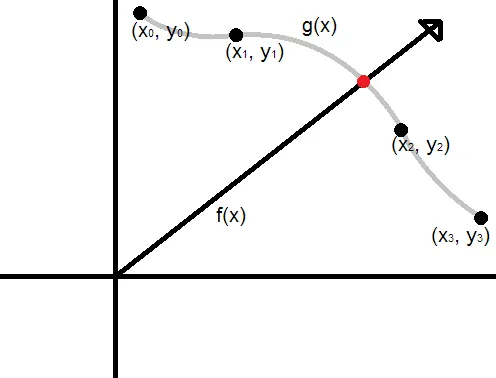
我需要一种程序化的方法来查找一条从原点开始的直线f(x)与由4个点定义的三次样条曲线相交的点。该直线保证与样条曲线的中心线段在X1和X2之间相交。
我尝试了许多方法,但似乎无法获得预期结果。我怀疑问题出在我对复数的处理上。
有人能找到我的代码问题,或者建议其他方法吗?
private Vector2 CubicInterpolatedIntersection(float y0, float y1,
float y2, float y3, float lineSlope, lineYOffset)
{
// f(x) = lineSlope * x + lineYOffset
// g(x) = (a0 * x^3) + (a1 * x^2) + (a2 * x) + a3
// Calculate Catmull-Rom coefficients for g(x) equation as found
// in reference (1). These
double a0, a1, a2, a3;
a0 = -0.5 * y0 + 1.5 * y1 - 1.5 * y2 + 0.5 * y3;
a1 = y0 - 2.5 * y1 + 2 * y2 - 0.5 * y3;
a2 = -0.5 * y0 + 0.5 * y2;
a3 = y1;
// To find POI, let 'g(x) - f(x) = 0'. Simplified equation is:
// (a0 * x^3) + (a1 * x^2) + ((a2 - lineSlope) * x)
// + (a3 - lineYOffset) = 0
// Put in standard form 'ax^3 + bx^2 + cx + d = 0'
double a, b, c, d;
a = a0;
b = a1;
c = a2 - lineSlope;
d = a3 - lineYOffset;
// Solve for roots using cubic equation as found in reference (2).
// x = {q + [q^2 + (r-p^2)^3]^(1/2)}^(1/3)
// + {q - [q^2 + (r-p^2)^3]^(1/2)}^(1/3) + p
// Where...
double p, q, r;
p = -b / (3 * a);
q = p * p * p + (b * c - 3 * a * d) / (6 * a * a);
r = c / (3 * a);
//Solve the equation starting from the center.
double x, x2;
x = r - p * p;
x = x * x * x + q * q;
// Here's where I'm not sure. The cubic equation contains a square
// root. So if x is negative at this point, then we need to proceed
// with complex numbers.
if (x >= 0)
{
x = Math.Sqrt(x);
x = CubicRoot(q + x) + CubicRoot(q - x) + p;
}
else
{
x = Math.Sqrt(Math.Abs(x));
// x now represents the imaginary component of
// a complex number 'a + b*i'
// We need to take the cubic root of 'q + x' and 'q - x'
// Since x is imaginary, we have two complex numbers in
// standard form. Therefore, we take the cubic root of
// the magnitude of these complex numbers
x = CubicRoot(Math.Sqrt(q * q + x * x)) +
CubicRoot(Math.Sqrt(q * q + -x * -x)) + p;
}
// At this point, x should hold the x-value of
// the point of intersection.
// Now use it to solve g(x).
x2 = x * x;
return new Vector2((float)Math.Abs(x),
(float)Math.Abs(a0 * x * x2 + a1 * x2 + a2 * x + a3));
}
References: